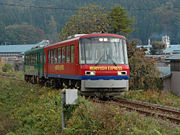
Akita Nairiku Jukan Railway Akita Nairiku Line
Encyclopedia

Akita Prefecture
is a prefecture of Japan located in the Tōhoku Region of northern Honshu, the main island of Japan. The capital is the city of Akita.- History :The area of Akita has been created from the ancient provinces of Dewa and Mutsu....
, between Takanosu
Takanosu Station
Takanosu Station is a station on the Ōu Main Line in Kita-Akita, Akita.-Lines:*JR East Ōu Main Line*Akita Nairiku Railway Akita Nairiku Line-Adjacent stations:...
, Kitaakita
Kitaakita, Akita
is a city located in Akita, Japan.The city was founded on March 22, 2005 from the merger of the former towns of Aikawa, Ani, Moriyoshi, and Takanosu, all from Kitaakita District....
and Kakunodate
Kakunodate Station
Kakunodate Station is a train station located in Senboku, Akita Prefecture, Japan.-Lines:*JR East**Akita Shinkansen**Tazawako Line *Akita Inland Rail Transport**Akita Inland Railway -History:...
, Senboku
Senboku, Akita
is a city located in Akita, Japan.- The city of Semboku :Semboku was created on September 20, 2005 from the merger of Kakunodate, Tazawako, and Nishiki, all from Senboku District...
. This is the only railway line operated by the . The third sector company took over two former Japanese National Railways
Japanese National Railways
, abbreviated or "JNR", was the national railway network of Japan from 1949 to 1987.-History:The term Kokuyū Tetsudō "state-owned railway" originally referred to a network of railway lines operated by nationalized companies under the control of the Railway Institute following the nationalization...
lines in 1986, and a newly built line linked the two in 1989. Since the line serves sparsely populated areas, it faces severe business challenges.
Basic data
- Distance: 94.2 km / 58.5 mi.
- GaugeRail gaugeTrack gauge or rail gauge is the distance between the inner sides of the heads of the two load bearing rails that make up a single railway line. Sixty percent of the world's railways use a standard gauge of . Wider gauges are called broad gauge; smaller gauges, narrow gauge. Break-of-gauge refers...
: 1,067 mm / 3 ft. 6 in. - Stations: 29
- Double-track line: None
- Electric supply: Not electrified
- Railway signallingRailway signallingRailway signalling is a system used to control railway traffic safely, essentially to prevent trains from colliding. Being guided by fixed rails, trains are uniquely susceptible to collision; furthermore, trains cannot stop quickly, and frequently operate at speeds that do not enable them to stop...
: Simplified automatic

